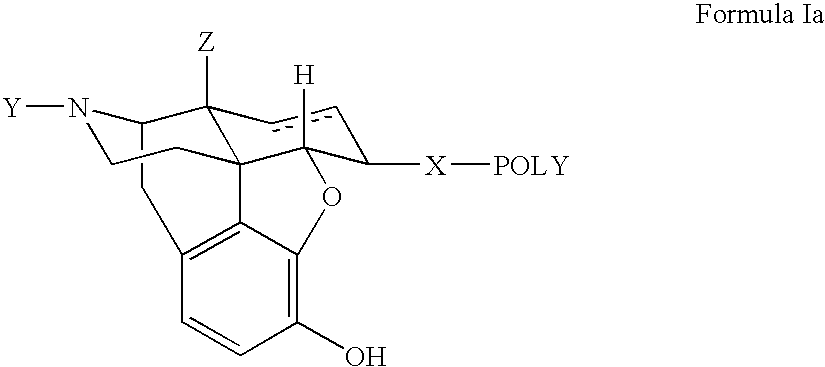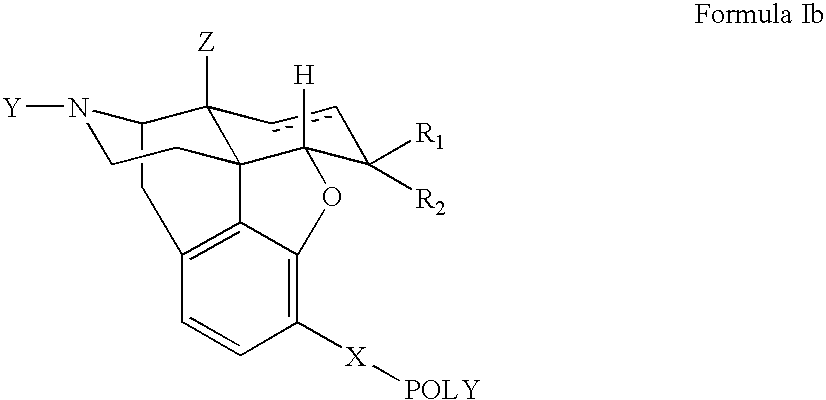Polymer conjugates of opioid antagonists
a polymer and antagonist technology, applied in the field of biologically active molecules watersoluble polymer conjugates, can solve the problems of opioid-induced side effects, serious problems, and gastrointestinal dysfunction, and achieve the effects of reducing the number of side effects, and improving the effect of gastrointestinal function
- Summary
- Abstract
- Description
- Claims
- Application Information
AI Technical Summary
Benefits of technology
Problems solved by technology
Method used
Image
Examples
example 1
Preparation of 6-mPEG (550 Da —NH-6-desoxo-naloxone (Mixture of 6-epimers)
A. Synthesis of 6-amino-6-desoxo-naloxone (Mixture of 6-amino epimers)
[0137]
[0138] Naloxone was subjected to reductive amination by methods similar to those of Jiang, et al. (J. Med. Chem., 20: 1100-1102, 1977). To a mixture of naloxone (7.4 g) and ammonium acetate (15.4 g) dissolved in methanol (50 ml) under nitrogen was added a methanolic solution (40 ml) of NaCNBH3 (1.4 g). The resulting solution was adjusted to pH 7.0 with concentrated HCl, stirred for 20 hours, and acidified to pH 1 with addition of concentrated HCl. After removal of the solvent and dissolution of the residue in water, the aqueous solution was extracted with chloroform to remove the water-insoluble material and was then adjusted to pH 9.0 with Na2CO3. The mixture was saturated with NaCl and extracted with CHCl3. The CHCl3 phase was dried with Na2SO4 and evaporated to dryness. The oily residue was dissolved in 60 ml of methanol, acidifie...
example 2
Preparation of 6-mPEG (550 Da)-CONH-6-desoxo-naloxone (Mixture of 6-epimers)
[0143]
[0144] mPEG (550) N-succinimidyl propionate (Shearwater Corporation, 4.0 g, 5.5 mmol) and 6-amino-6-desoxo-naloxone (2.0 g, 6.1 mmol) (from Step A of Example 1) were dissolved in CHCl3 (50 ml) under argon. The solution was stirred at room temperature under argon overnight (20 h). CHCl3 (250 ml) was added and the solution was extracted with pH 1 HCl solution (3×200 ml). To the combined aqueous extracts was and extracted with CHCl3 (3×200 ml). The CHCl3 extracts were combined, washed with a pH 5.5 phosphate buffer solution (50 mM, 3×200 ml), dried over anhydrous Na2SO4 and filtered. All solvents were removed with a rotary evaporator and the resulting product was dried in vacuo for 2 days to give pure m-PEG-550-CONH-Naloxone conjugate as a colorless liquid (3.5 g, 3.7 mmol, 66% yield).
[0145]1H NMR (CDCl3): δ 7.12 and 6.88 (1H, two doublet, NHCO of α and β conjugates); 6.50-6.71 (2H, multiplet, aromatic ...
example 3
Synthesis of mPEG (2000 Da)-6-desoxo-naloxone
[0146]
[0147] To a mixture of 6-amino-6-desoxonaloxone.2HCl (0.6 g) (from Step A of Example 1) and MPEG (2000 Da)-propionaldehyde (6.0 g) dissolved in 0.1 M phosphate buffer pH 6.5 was added phosphate buffer solution (pH 6.5, 5 ml) of NaCNBH3. The resulting solution was stirred at room temperature under argon overnight. The reaction mixture was diluted to 500 ml, saturated with NaCl and extracted with dichloromethane. The extracted dichloromethane was dried with Na2SO4, evaporated and precipitated with ethyl ether. The product was dried under vacuum overnight. Yield: 5.63 g GPC: ˜25% of conjugates.
[0148] The mixture product was purified through cation exchange chromatography using Poros 50 HS resin (100 ml). The mixture was dissolved in 200 ml of deionized water and was loaded on cation exchange column (3.5×28 cm). After column was washed with 500 ml of deionized water, 1N NaCl solution (500 ml) was used to elute the column. The desired ...
PUM
| Property | Measurement | Unit |
|---|---|---|
| molecular weight | aaaaa | aaaaa |
| molecular weight | aaaaa | aaaaa |
| molecular weight | aaaaa | aaaaa |
Abstract
Description
Claims
Application Information
 Login to View More
Login to View More - R&D
- Intellectual Property
- Life Sciences
- Materials
- Tech Scout
- Unparalleled Data Quality
- Higher Quality Content
- 60% Fewer Hallucinations
Browse by: Latest US Patents, China's latest patents, Technical Efficacy Thesaurus, Application Domain, Technology Topic, Popular Technical Reports.
© 2025 PatSnap. All rights reserved.Legal|Privacy policy|Modern Slavery Act Transparency Statement|Sitemap|About US| Contact US: help@patsnap.com



